 Facebook
Facebook
 X
X
 Instagram
Instagram
 TikTok
TikTok
 Youtube
Youtube

I thought I knew Mission Hills. After all, I’ve eaten at a couple dozen restaurants there and can rattle off recommendations like a pro. I know there’s a library serving the neighborhood, but that a new library will soon be built to replace it. I know there used to be an authentic German butcher called Sausage King on Washington Street, and since the couple who owned the shop retired and closed its doors five years ago the San Diego sausage-scape has never been the same.
But these are the observations of a passerby. I drive through Mission Hills often enough to feel like it holds no surprises, yet rarely have I slowed down to take a look at what makes the neighborhood one of the city’s most impressive.
Well, this summer I slowed down, got out of my car, and took a closer look.
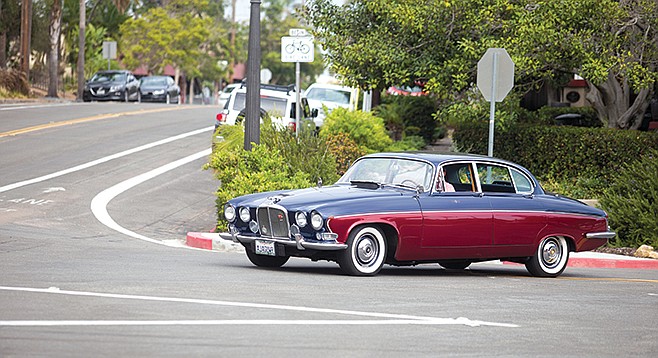
Where exactly is Mission Hills? That sounds like an easy question, but the answer involves a bit of confusion. Google Maps claims it’s entirely north of Washington Street and west of Dove Street. City documents also put the border roughly at Dove but extend it south to include the hillsides east of Curlew and Reynard Way, effectively down to Laurel Street. Real estate maps depict a much bigger neighborhood, of course, claiming all of the above as long as it’s east of Interstate 5. Because Mission Hills property sells at a premium.
My thinking is this: like many San Diego neighborhoods, there’s a sequence of streets running through Mission Hills in alphabetical order. Pacific Beach streets are named after gem stones (Diamond, Feldspar, Garnet…). Coming north out of downtown, streets are named for trees (Ash, Beech, Cedar…). In Mission Hills, streets are named after birds: Curlew, Dove, Eagle — all the way up to Jackdaw and Lark. But the bird streets don’t start at Dove or even Curlew; they start at Albatross. And they include Brant (apparently some kind of goose). I just can’t see any way around calling Albatross a street in Mission Hills, though it is east of Reynard Way.
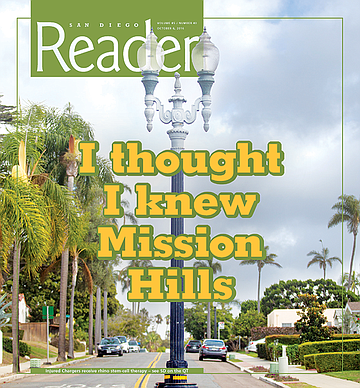
Potentially more confusing is the western boundary. Here again, both Google and the city disagree with the real estate crowd, calling the entire western slope of the hills overlooking Interstate 5 between Old Town and Little Italy “Middletown.”
I asked Ralph Pesqueira, Jr., about this. His father started El Indio Restaurant (3695 India Street) 76 years ago, and Ralph grew up for a time in Mission Hills. He recalls a time when people still called downtown “New Town” and sums up the Middletown moniker pretty succinctly: “You have Old Town and New Town, and what do you call the land in the middle? Middletown.”
He makes a strong case, and officially he is correct. But many people who live there call the area Mission Hills anyway — I assume because it’s literally the main source of hills in the entire neighborhood. In this case, I will defer to the judgment of another website directing people to the neighborhood: Yelp.
Because Yelp considers all the restaurants along India Street to be Mission Hills restaurants, it also places the western border of the neighborhood at Interstate 5. I prefer this reading, because if there’s one thing I already knew about Mission Hills is that it’s quietly got one of the better restaurant scenes in the city, and I don’t want to have to start writing about how much I like Middletown dining.
Not lost in all this is that the unquestioned center of Mission Hills sits west of Hillcrest, up the hill from Old Town and Middletown, and overlooking Mission Valley to the north. That’s where the real history of the neighborhood may be found.
A 1907 pamphlet issued by the Inspiration Heights real estate company offered the following selling points for its collection of undeveloped single-home lots that would eventually become a sub-sect of Mission Hills:
“At your feet lies the Harbor, its mirror of amethyst held safe from the surges of the outer sapphire sea by the gigantic elbow of Point Loma, and the long low reaches of Coronado, whose gleaming line is fretted by the picturesque towers of the world-famed hotel… looking to the west, you see first, the little ‘Old Town’ of San Diego and the hamlet of Pacific Beach, then Mission Bay separated by the ocean by a silvery strand against which the breakers are constantly pounding and foaming.”
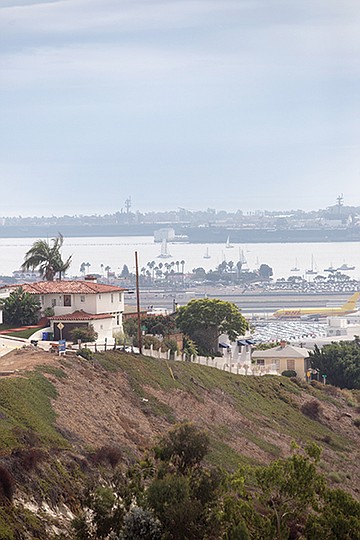
My first thought: this ornate prose makes it evident how lazy the language of modern-day real estate listings has become. Second: over a century later, you’d have to update some of those descriptions to include the less-pristine aspects of the 2016 view: the bustling gray expanse of airport tarmac; the thick, humming cables of an elevated freeway system; the low, blocky silhouettes of defense contractor compounds interrupting a sea of red-tile rooftops capping sturdy beige military barracks.
It’s still a tasty view, though. Pacific Beach is less hamlet these days and more unrepentant sprawl. But there’s now an impressive bridge crossing to Coronado and a glittering medium-sized city skyline showing off what “new town” has become. Meanwhile, those blue bays with their hugging peninsulas do retain most of the scenic charm that earned Inspiration Heights its name.
Actually, before that it was called Inspiration Point. That name was given by ship captain Henry James Johnston in 1868, when he paid a whopping 15 dollars for the wild 60-acre parcel known as Pueblo Lot #1121.
Johnston captained the steamboat Orizaba, said to be sort of the Mayflower of San Diego for the number of new residents it brought to town from post–Gold Rush San Francisco. According to old-time San Diego newspaperman Jerry MacMullen, that captain with the terrifically 19th-century nickname, Ninety Fathom Johnston, would aim for the same hilltop every time he navigated his boat around the tip of Point Loma and “dreamed of a home on the hills overlooking the bay.”
There are probably a few thousand Inspiration Points in the world, and likely more than a couple in San Diego alone. The City of San Diego lists Inspiration Point as being near the top of Presidio Park (2811 Jackson Street). It’s a shady area with picnic tables and a view of Mission Valley that may be reserved for small weddings and memorials.
But Johnston’s Point sits about a thousand yards to the southeast, on a slope facing west. The boat captain died in San Francisco before he got a chance to live out his San Diego dream, but in 1887 his daughter Sarah followed through, building the first home in Mission Hills — Villa Orizaba (2036 Orizaba Avenue), named for her father’s boat.
Of course, at that time she referred to the neighborhood as Johnston Heights, missing a clear opportunity to call it Ninety Fathom Hills. On the other hand, Sarah did get about 125 years ahead of the reclaimed-wood craze by using materials from the namesake steamship to build the banister and other fixtures in Villa Orizaba, so let’s give her credit with being a visionary.
More credit than her son did, at least. Apparently, Henry Miller (no relation to the kinky author) was dissatisfied with the Victorian home she built, as well as its location. By 1919 he had remodeled Villa Orizaba into a prairie-style home and moved it to its current location at 2036 Orizaba Street. By that time, Miller had changed the name of Johnston Road to its current incarnation, Sunset Boulevard, and sold most of Johnston Heights to the Inspiration Heights Company, which came up with that early pamphlet.
In 1907, a real estate group named Gordon, Goodwin & Co. paid $36,000 for its own 60-acre portion of the mesa — showing the land had increased 240,000 percent in value in the 40 years since Captain Johnston. Not long after, city father George Marston picked up 22 acres himself; he is typically credited with giving the place the name that ultimately stuck — Mission Hills — possibly just because he knew where to submit his subdivision maps to the city.
However, the biggest reason the land in Mission Hills started gaining interest at this time was a city mother of San Diego. Kate Sessions is better known as the Mother of Balboa Park because she famously convinced the city to let her establish a 30-acre nursery there in return for planting hundreds of trees each year in the park and throughout the city. Turns out, that deal ended in 1903, and Sessions started looking around for a new nursery location.
Aside from Villa Orizaba and a Calvary cemetery, California historian Alexander Bevil described the area of that time as “nothing more than a vast hayfield on a mesa top overlooking Mission Valley.” Simply put, nobody had done anything with it, because between 1880 and 1890 the population of San Diego dropped from 40,000 people to under 17,000, meaning land for housing wasn’t exactly in demand.
Sessions bought up a big chunk of empty real estate and started her new nursery on 14 acres of it, north of what is now Pioneer Park, at the south end of a section of Mission Hills aptly known as Florence Heights. A smaller version of that nursery still exists — though by modern standards the acre it sits on seems pretty large for an urban garden center.
The sign over Mission Hills Nursery says it was established in 1910, though Sessions was definitely there growing plants before then. In 1908 she successfully lobbied John D. Spreckels, another city-father type, to make sure his expanding street-car line made a stop in Mission Hills, so more customers could pay her a visit.
Even in those days, the promise of a public transit stop prompted all those developers to start buying up parcels. And, if you didn’t already think Sessions had some keen business sense, guess who it was who sold George Marston his 22 acres?
Kate Sessions herself is said to have lived in three Mission Hills homes. It’s also been noted she held a strange yet strong aversion to white sidewalks, apparently considering them quite garish. Since we know she was a woman who knew how to get things done, it’s little surprise that you’ll still find, in a few parts of the neighborhood, the sidewalks are pink.

That said, developers wanting to sell the land didn’t immediately translate to buyers wanting to build on it. There was a little activity early on, but the population of San Diego didn’t start to pick up again until the Panama Canal opened in 1914. It’s right around that time many of Mission Hills’ oldest remaining homes started to turn up.
All told, there are more than 320 designated historic homes in Mission Hills, the most of any neighborhood besides Sherman Heights. If you walk the neighborhood north of Washington Street and west of Goldfinch, you’ll spot them everywhere, often one after another, each bearing a bronze plaque and each more beautiful than the last. About 130 are Craftsman homes, while 100 are of the adobe-styled school dubbed “Spanish eclectic.” Sixty or so are prairie homes; there a handful each of Tudor and Mission revival style, and at least two much newer but pretty fun-looking front-yard treehouses.
Most of the not-designated-historic homes in Mission Hills are pretty impressive, too. It’s a breathtaking neighborhood for a late-evening walk, making easy to see why home values here top a million dollars at the lower end of the market.
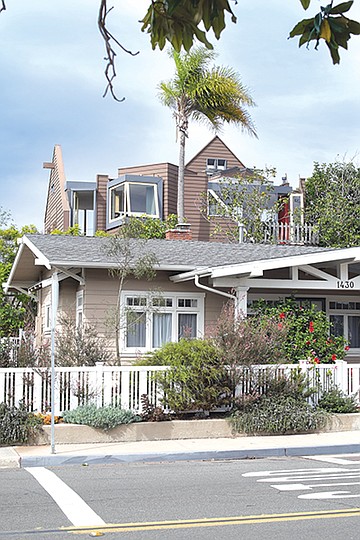
Tom Curl, an agent with Ascent Real Estate, has been in Mission Hills all his life and says home values in the neighborhood weren’t even impacted much by the real estate crash of 2008. He says the homes on the outer ring of the neighborhood — those with views of Mission Valley, Mission Bay and Point Loma — sell at a premium. A 4500-square-foot brick house on a quarter acre at 1945 Sunset was listed for sale at $3.6 million in late September.
If you want to get technical about it, the first building in Mission Hills wasn’t Villa Orizaba, but the original Mission Basilica San Diego de Alcalá established by missionary Junípero Serra back in 1769. That, and the Presidio built by the garrison of Spanish soldiers sent to protect it. The mission moved on after five years, and the Presidio eventually fell into ruin, but not before retiring soldiers became some of the first settlers down the hill at Old Town.
Recognizing the importance of this history, George Marston and several of his civic-minded compatriots bought 20 acres of the old Presidio site in 1907 — not to build homes, but to establish Presidio Park and build the Junípero Serra Museum, which commemorates the mission’s history, as well as that of the native Kumeyaay tribe.
Marston enlisted architect William Templeton Johnson to design the museum. Johnson may be better known for designing the Athenaeum and the Museum of Art, but he left a big mark on Mission Hills. He made his own home there, and with his wife Clara Sturgess Johnson, designed and founded the Francis Parker School, a private school in the northeast corner of Mission Hills that celebrated its centennial in 2013. An interesting tidbit: the first principal of Francis Parker, Ethal Dumer Mintzer, also served as the first president of the San Diego League of Women Voters.
The streets of residential Mission Hills are among the most serene in the city, and some of the best for dog-walking I’ve ever experienced. Homes range from charming bungalows to stately manors, with a few bona fide mansions thrown in. It’s a wonderful place to get lost, with plenty of beautiful architecture to admire.
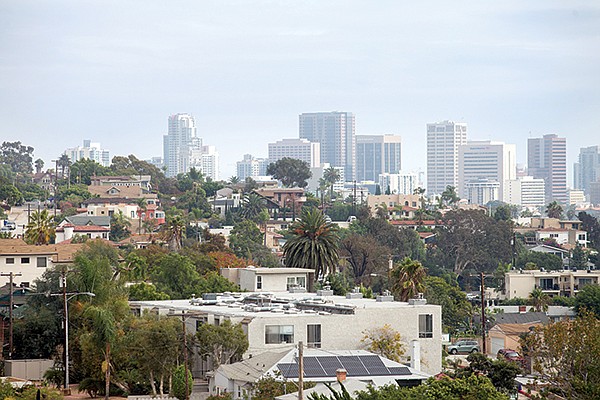
Periodically, one will find oneself at the edge of a canyon or hillside, and get a glimpse of the views available from these homes — the University of San Diego campus across the valley to the north, the bays and ocean to the south and west. If it’s any consolation to the homeowners in the middle of the neighborhood, there’s a lot of train and freeway noise coming up those hills. It’s a bit quieter in the center.
Most of the 500 businesses that call Mission Hills home radiate outward from the intersection of Washington and Goldfinch streets — these are the familiar restaurants and shops I associate with the neighborhood. But if you wander about a half mile northwest of there, you’ll find a cozy pocket of business district along a three-block strip of Lewis Street, west of Lark.
Notable reasons to visit include the coffee and gifts shop Kettle & Stone, the cheesemongering Mission Hills Wine Cellar, and Mission Hills Liquor, which serves as craft-beer bottle shop in addition to corner market and deli. But by far, most of storefronts on these blocks contain small clothing boutiques and beauty salons. Judging by the number of boutiques and salons that manage to stay open, the women of Mission Hills must be among the best dressed and well groomed in the city.
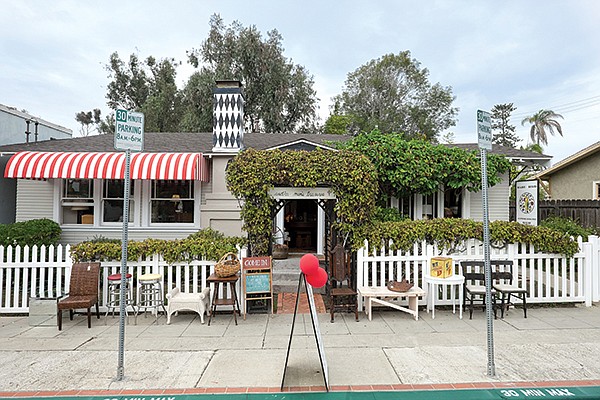
As if the Lewis businesses weren’t tucked away enough, there’s an even smaller commercial block further west on Fort Stockton, where it intersects Hickory Street. There’s a private art gallery here, as well as a home design store. But the greatest reason to seek it out is the adorable Rare Bird Consignment House (1918 Fort Stockton Drive). The highly selective used-furniture shop fills the rooms of a small cottage — seek out the kitchen for kitchen wares, the bedroom for bedroom furniture — you get the gist.
Until this summer, the small stretch of businesses included a tiny coffee shop called Espresso Mio. That moved to a new location, and rumor has it a restaurant will eventually take its place here, deep in the residential heart of the neighborhood.
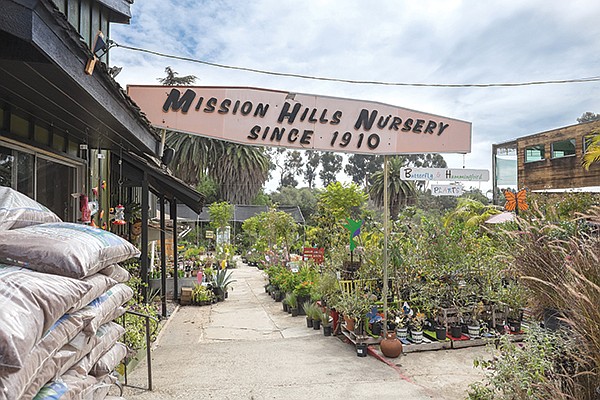
Fans of Espresso Mio needn’t look far to find its reincarnation — a cute little outdoor coffee bar setup over at Mission Hills Nursery. Open to the sidewalk, with a little garden seating, it’s only been operating a few weeks but already proving a welcome destination for outdoors-loving, dog-walking coffee drinkers.
The nursery remains one of the best reasons to shop in Mission Hills, period. Though considerably smaller than the shop Kate Sessions established at the beginning of the 20th Century, it’s still a very nice, well-stocked nursery that, for the past 15 years or so has focused on organics.
Back in 1989, current owner Fausto Palafax bought the nursery from the Antonicelli family, whose forbears were among Sessions’ original employees. They bought the nursery from Sessions in the 1920s and built up the business in part as a poinsettia field, dedicated to growing the holiday flower.
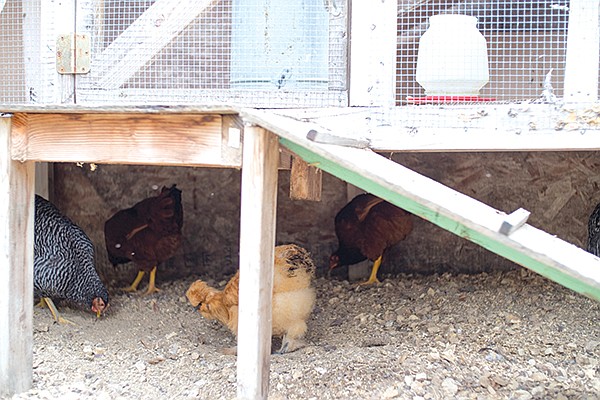
These days, a lot of children in the neighborhood like to pass through and look at the nursery’s chicken coop. Keep an eye out for the pretty little brown silkie chicken — she likes to hide under the raised chicken coop because she knows there’s a hungry red-tail hawk lurking in the fir trees overhead.
Outside of Presidio Park, Mission Hills’ most significant public outdoor space is Pioneer Park. Situated beside Grant elementary school, it’s used as a community hub, offering free summer concerts, neighborhood parties, and an annual 4th of July BBQ competition. Even when there’s no event, you can usually find dogs and children frolicking on about six acres of green grass.
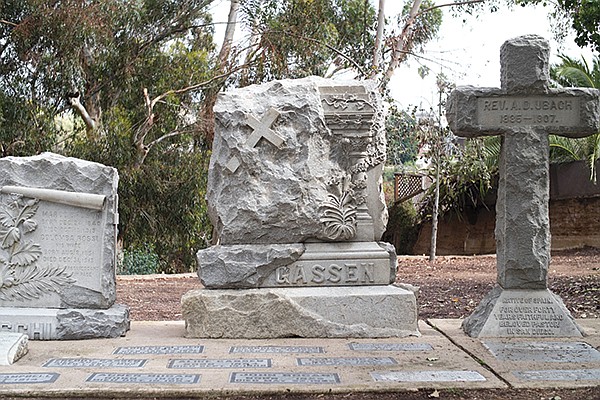
Which makes it kind of creepy that, beneath that well-maintained turf lie what remains of 4000 early San Diego settlers buried here when the tract was called Calvary Cemetery. The Catholic cemetery was one of the first in San Diego and dates back even further than Villa Orizaba — with bodies interred as early as 1875. The last burial took place around 1960, and in 1970 the city converted it to the park the neighborhood enjoys today.
However, much like the plot of the movie Poltergeist, the city only moved the headstones! The remains remained, giving rise to plenty of ghost stories over the years and contributing to Mission Hills’ reputation as a killer trick-or-treating destination.
Some of the tombstones were kept onsite, grouped together and set in concrete in the southeast corner of the park. There you’ll find markers commemorating fallen members of the 7th Kansas Calvary and California Native Cavalry, as well as a half dozen Irish priests who lived and died here in the late 19th Century as missionaries.
There are also stones for some of Old Town’s prominent early families, such as the Bandinis and the Coutses, both also memorialized in the names of Mission Hills streets.
Officially, there’s a third city park in the ’hood — Mission Hills Park. However, good luck finding a way into it. This park is really just a half-barren ravine descending a hillside south of Villa Orizaba and is completely encircled by private properties. You might be able to cut through a couple yards to access the unkempt scrub and steep terrain, but I can’t imagine why anyone would want to.
Only two blocks south of that you may find a larger, very similar plot of open gully descending from the Mission Hills tennis courts (4020 Randolph Street) across the street from Pioneer Park. Known as Robyn’s Egg Trail (for reasons I could not ascertain), this short stretch of hike is not an official park, merely a designated open space.
That said, it’s in every way more pleasant than Mission Hills Park. I didn’t enjoy it, but if you feel the need to walk from the top of Mission Hills down to San Diego Avenue, it’s probably the most direct route.
One of the coolest little bit of outdoors in these Hills is the elaborate topiary garden on Vine Street, two blocks east of India Street and one block north of Upas. Harper’s Topiary Garden (3549 Union Street) fronts the steep hillside lawn of a private home, and all the manicured plants may be easily viewed from the street. Everyone should respect the privacy of the Harper family here but should take a look sometime at the professionally groomed menagerie of animal likenesses, including a rabbit, whale, caterpillar, rooster, cat, and dragon.
There’s one other outdoor activity worth pursuing in Mission Hills that’s not like the others. Cinema Under the Stars offers weekend film screenings in an enclosed outdoor setting. Deluxe lawnchair seating and reasonably priced concessions make viewing old films on this small screen a pleasant alternative to the garish noise of a multiplex.
Most weekends you may expect to find classics, quite often starring Humphrey Bogart or directed by Alfred Hitchcock. But cult films such as The Big Lebowski and The Princess Bride turn up as well, and this summer it screened the latest Star Wars episode.
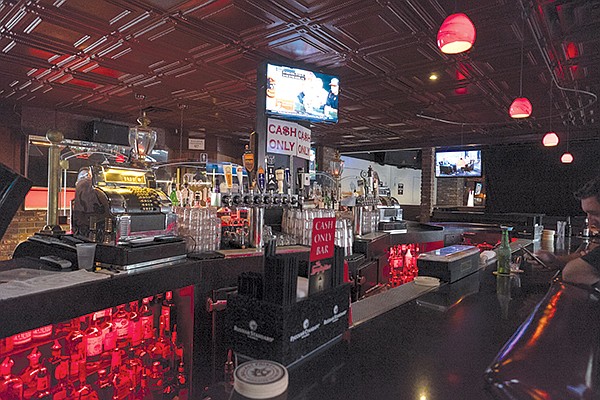
Mission Hills’ oldest nightlife option dates back to 1957 — the Lamplighter. I don’t know if it was intended as a dive bar 70 years ago, but it does the 6 a.m. first crack at alcohol thing pretty convincingly now. I do know Lamplighter didn’t start out as a karaoke bar, but it has become the city’s premiere karaoke venue, with amateur crooners signing up to sing after 9 nightly.
Another longtime nightlife destination in Mission Hills recently closed. After more than 16 years, the club called Bar Dynamite shut its doors at the end of July. To give you an idea how long a run the dance venue enjoyed — back when it opened, DJs still primarily played vinyl records.
To give another example what a crazy long run it is for a nightclub to last 16 years — the world’s most famous dance club of all time, Studio 54, lasted 11 years. So, congratulations, Bar Dynamite on outlasting Studio 54!
The Bar Dynamite space didn’t sit empty long. In the middle of August, a new venue opened in its place. Overseen by a team of longtime San Diego musicians, bartenders, and DJs, Blonde Bar will continue a couple of the dance-music nights that made Dynamite memorable, but presents itself more as a NYC-type club in the vein of CBGB. Expect plenty of live rock music to go with beer and cocktails, with classic albums playing on vinyl when there aren’t any bands or DJs.
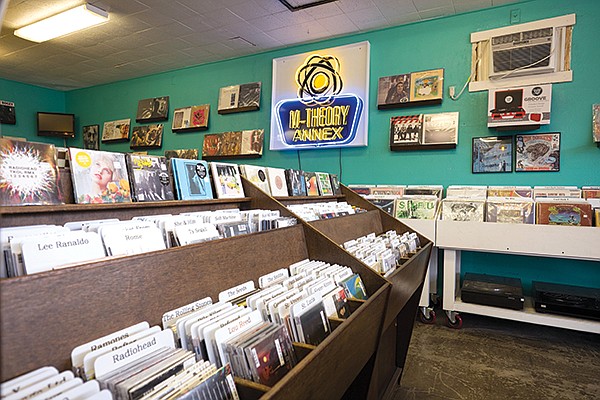
Speaking of vinyl, they still sell it at M Theory Music, along with CDs and even cassette tapes. One of the few independent music shops remaining in San Diego, M Theory still feels like a record shop from the 1990s — in the best possible way — right down to the CD listening stations where you may don a pair of headphones and try out new music before you buy. Occasionally, nationally known touring artists perform in the store.


I thought I knew Mission Hills. After all, I’ve eaten at a couple dozen restaurants there and can rattle off recommendations like a pro. I know there’s a library serving the neighborhood, but that a new library will soon be built to replace it. I know there used to be an authentic German butcher called Sausage King on Washington Street, and since the couple who owned the shop retired and closed its doors five years ago the San Diego sausage-scape has never been the same.
But these are the observations of a passerby. I drive through Mission Hills often enough to feel like it holds no surprises, yet rarely have I slowed down to take a look at what makes the neighborhood one of the city’s most impressive.
Well, this summer I slowed down, got out of my car, and took a closer look.

Where exactly is Mission Hills? That sounds like an easy question, but the answer involves a bit of confusion. Google Maps claims it’s entirely north of Washington Street and west of Dove Street. City documents also put the border roughly at Dove but extend it south to include the hillsides east of Curlew and Reynard Way, effectively down to Laurel Street. Real estate maps depict a much bigger neighborhood, of course, claiming all of the above as long as it’s east of Interstate 5. Because Mission Hills property sells at a premium.
My thinking is this: like many San Diego neighborhoods, there’s a sequence of streets running through Mission Hills in alphabetical order. Pacific Beach streets are named after gem stones (Diamond, Feldspar, Garnet…). Coming north out of downtown, streets are named for trees (Ash, Beech, Cedar…). In Mission Hills, streets are named after birds: Curlew, Dove, Eagle — all the way up to Jackdaw and Lark. But the bird streets don’t start at Dove or even Curlew; they start at Albatross. And they include Brant (apparently some kind of goose). I just can’t see any way around calling Albatross a street in Mission Hills, though it is east of Reynard Way.

Potentially more confusing is the western boundary. Here again, both Google and the city disagree with the real estate crowd, calling the entire western slope of the hills overlooking Interstate 5 between Old Town and Little Italy “Middletown.”
I asked Ralph Pesqueira, Jr., about this. His father started El Indio Restaurant (3695 India Street) 76 years ago, and Ralph grew up for a time in Mission Hills. He recalls a time when people still called downtown “New Town” and sums up the Middletown moniker pretty succinctly: “You have Old Town and New Town, and what do you call the land in the middle? Middletown.”
He makes a strong case, and officially he is correct. But many people who live there call the area Mission Hills anyway — I assume because it’s literally the main source of hills in the entire neighborhood. In this case, I will defer to the judgment of another website directing people to the neighborhood: Yelp.
Because Yelp considers all the restaurants along India Street to be Mission Hills restaurants, it also places the western border of the neighborhood at Interstate 5. I prefer this reading, because if there’s one thing I already knew about Mission Hills is that it’s quietly got one of the better restaurant scenes in the city, and I don’t want to have to start writing about how much I like Middletown dining.
Not lost in all this is that the unquestioned center of Mission Hills sits west of Hillcrest, up the hill from Old Town and Middletown, and overlooking Mission Valley to the north. That’s where the real history of the neighborhood may be found.
A 1907 pamphlet issued by the Inspiration Heights real estate company offered the following selling points for its collection of undeveloped single-home lots that would eventually become a sub-sect of Mission Hills:
“At your feet lies the Harbor, its mirror of amethyst held safe from the surges of the outer sapphire sea by the gigantic elbow of Point Loma, and the long low reaches of Coronado, whose gleaming line is fretted by the picturesque towers of the world-famed hotel… looking to the west, you see first, the little ‘Old Town’ of San Diego and the hamlet of Pacific Beach, then Mission Bay separated by the ocean by a silvery strand against which the breakers are constantly pounding and foaming.”

My first thought: this ornate prose makes it evident how lazy the language of modern-day real estate listings has become. Second: over a century later, you’d have to update some of those descriptions to include the less-pristine aspects of the 2016 view: the bustling gray expanse of airport tarmac; the thick, humming cables of an elevated freeway system; the low, blocky silhouettes of defense contractor compounds interrupting a sea of red-tile rooftops capping sturdy beige military barracks.
It’s still a tasty view, though. Pacific Beach is less hamlet these days and more unrepentant sprawl. But there’s now an impressive bridge crossing to Coronado and a glittering medium-sized city skyline showing off what “new town” has become. Meanwhile, those blue bays with their hugging peninsulas do retain most of the scenic charm that earned Inspiration Heights its name.
Actually, before that it was called Inspiration Point. That name was given by ship captain Henry James Johnston in 1868, when he paid a whopping 15 dollars for the wild 60-acre parcel known as Pueblo Lot #1121.
Johnston captained the steamboat Orizaba, said to be sort of the Mayflower of San Diego for the number of new residents it brought to town from post–Gold Rush San Francisco. According to old-time San Diego newspaperman Jerry MacMullen, that captain with the terrifically 19th-century nickname, Ninety Fathom Johnston, would aim for the same hilltop every time he navigated his boat around the tip of Point Loma and “dreamed of a home on the hills overlooking the bay.”
There are probably a few thousand Inspiration Points in the world, and likely more than a couple in San Diego alone. The City of San Diego lists Inspiration Point as being near the top of Presidio Park (2811 Jackson Street). It’s a shady area with picnic tables and a view of Mission Valley that may be reserved for small weddings and memorials.
But Johnston’s Point sits about a thousand yards to the southeast, on a slope facing west. The boat captain died in San Francisco before he got a chance to live out his San Diego dream, but in 1887 his daughter Sarah followed through, building the first home in Mission Hills — Villa Orizaba (2036 Orizaba Avenue), named for her father’s boat.
Of course, at that time she referred to the neighborhood as Johnston Heights, missing a clear opportunity to call it Ninety Fathom Hills. On the other hand, Sarah did get about 125 years ahead of the reclaimed-wood craze by using materials from the namesake steamship to build the banister and other fixtures in Villa Orizaba, so let’s give her credit with being a visionary.
More credit than her son did, at least. Apparently, Henry Miller (no relation to the kinky author) was dissatisfied with the Victorian home she built, as well as its location. By 1919 he had remodeled Villa Orizaba into a prairie-style home and moved it to its current location at 2036 Orizaba Street. By that time, Miller had changed the name of Johnston Road to its current incarnation, Sunset Boulevard, and sold most of Johnston Heights to the Inspiration Heights Company, which came up with that early pamphlet.
In 1907, a real estate group named Gordon, Goodwin & Co. paid $36,000 for its own 60-acre portion of the mesa — showing the land had increased 240,000 percent in value in the 40 years since Captain Johnston. Not long after, city father George Marston picked up 22 acres himself; he is typically credited with giving the place the name that ultimately stuck — Mission Hills — possibly just because he knew where to submit his subdivision maps to the city.
However, the biggest reason the land in Mission Hills started gaining interest at this time was a city mother of San Diego. Kate Sessions is better known as the Mother of Balboa Park because she famously convinced the city to let her establish a 30-acre nursery there in return for planting hundreds of trees each year in the park and throughout the city. Turns out, that deal ended in 1903, and Sessions started looking around for a new nursery location.
Aside from Villa Orizaba and a Calvary cemetery, California historian Alexander Bevil described the area of that time as “nothing more than a vast hayfield on a mesa top overlooking Mission Valley.” Simply put, nobody had done anything with it, because between 1880 and 1890 the population of San Diego dropped from 40,000 people to under 17,000, meaning land for housing wasn’t exactly in demand.
Sessions bought up a big chunk of empty real estate and started her new nursery on 14 acres of it, north of what is now Pioneer Park, at the south end of a section of Mission Hills aptly known as Florence Heights. A smaller version of that nursery still exists — though by modern standards the acre it sits on seems pretty large for an urban garden center.
The sign over Mission Hills Nursery says it was established in 1910, though Sessions was definitely there growing plants before then. In 1908 she successfully lobbied John D. Spreckels, another city-father type, to make sure his expanding street-car line made a stop in Mission Hills, so more customers could pay her a visit.
Even in those days, the promise of a public transit stop prompted all those developers to start buying up parcels. And, if you didn’t already think Sessions had some keen business sense, guess who it was who sold George Marston his 22 acres?
Kate Sessions herself is said to have lived in three Mission Hills homes. It’s also been noted she held a strange yet strong aversion to white sidewalks, apparently considering them quite garish. Since we know she was a woman who knew how to get things done, it’s little surprise that you’ll still find, in a few parts of the neighborhood, the sidewalks are pink.

That said, developers wanting to sell the land didn’t immediately translate to buyers wanting to build on it. There was a little activity early on, but the population of San Diego didn’t start to pick up again until the Panama Canal opened in 1914. It’s right around that time many of Mission Hills’ oldest remaining homes started to turn up.
All told, there are more than 320 designated historic homes in Mission Hills, the most of any neighborhood besides Sherman Heights. If you walk the neighborhood north of Washington Street and west of Goldfinch, you’ll spot them everywhere, often one after another, each bearing a bronze plaque and each more beautiful than the last. About 130 are Craftsman homes, while 100 are of the adobe-styled school dubbed “Spanish eclectic.” Sixty or so are prairie homes; there a handful each of Tudor and Mission revival style, and at least two much newer but pretty fun-looking front-yard treehouses.
Most of the not-designated-historic homes in Mission Hills are pretty impressive, too. It’s a breathtaking neighborhood for a late-evening walk, making easy to see why home values here top a million dollars at the lower end of the market.

Tom Curl, an agent with Ascent Real Estate, has been in Mission Hills all his life and says home values in the neighborhood weren’t even impacted much by the real estate crash of 2008. He says the homes on the outer ring of the neighborhood — those with views of Mission Valley, Mission Bay and Point Loma — sell at a premium. A 4500-square-foot brick house on a quarter acre at 1945 Sunset was listed for sale at $3.6 million in late September.
If you want to get technical about it, the first building in Mission Hills wasn’t Villa Orizaba, but the original Mission Basilica San Diego de Alcalá established by missionary Junípero Serra back in 1769. That, and the Presidio built by the garrison of Spanish soldiers sent to protect it. The mission moved on after five years, and the Presidio eventually fell into ruin, but not before retiring soldiers became some of the first settlers down the hill at Old Town.
Recognizing the importance of this history, George Marston and several of his civic-minded compatriots bought 20 acres of the old Presidio site in 1907 — not to build homes, but to establish Presidio Park and build the Junípero Serra Museum, which commemorates the mission’s history, as well as that of the native Kumeyaay tribe.
Marston enlisted architect William Templeton Johnson to design the museum. Johnson may be better known for designing the Athenaeum and the Museum of Art, but he left a big mark on Mission Hills. He made his own home there, and with his wife Clara Sturgess Johnson, designed and founded the Francis Parker School, a private school in the northeast corner of Mission Hills that celebrated its centennial in 2013. An interesting tidbit: the first principal of Francis Parker, Ethal Dumer Mintzer, also served as the first president of the San Diego League of Women Voters.
The streets of residential Mission Hills are among the most serene in the city, and some of the best for dog-walking I’ve ever experienced. Homes range from charming bungalows to stately manors, with a few bona fide mansions thrown in. It’s a wonderful place to get lost, with plenty of beautiful architecture to admire.

Periodically, one will find oneself at the edge of a canyon or hillside, and get a glimpse of the views available from these homes — the University of San Diego campus across the valley to the north, the bays and ocean to the south and west. If it’s any consolation to the homeowners in the middle of the neighborhood, there’s a lot of train and freeway noise coming up those hills. It’s a bit quieter in the center.
Most of the 500 businesses that call Mission Hills home radiate outward from the intersection of Washington and Goldfinch streets — these are the familiar restaurants and shops I associate with the neighborhood. But if you wander about a half mile northwest of there, you’ll find a cozy pocket of business district along a three-block strip of Lewis Street, west of Lark.
Notable reasons to visit include the coffee and gifts shop Kettle & Stone, the cheesemongering Mission Hills Wine Cellar, and Mission Hills Liquor, which serves as craft-beer bottle shop in addition to corner market and deli. But by far, most of storefronts on these blocks contain small clothing boutiques and beauty salons. Judging by the number of boutiques and salons that manage to stay open, the women of Mission Hills must be among the best dressed and well groomed in the city.

As if the Lewis businesses weren’t tucked away enough, there’s an even smaller commercial block further west on Fort Stockton, where it intersects Hickory Street. There’s a private art gallery here, as well as a home design store. But the greatest reason to seek it out is the adorable Rare Bird Consignment House (1918 Fort Stockton Drive). The highly selective used-furniture shop fills the rooms of a small cottage — seek out the kitchen for kitchen wares, the bedroom for bedroom furniture — you get the gist.
Until this summer, the small stretch of businesses included a tiny coffee shop called Espresso Mio. That moved to a new location, and rumor has it a restaurant will eventually take its place here, deep in the residential heart of the neighborhood.

Fans of Espresso Mio needn’t look far to find its reincarnation — a cute little outdoor coffee bar setup over at Mission Hills Nursery. Open to the sidewalk, with a little garden seating, it’s only been operating a few weeks but already proving a welcome destination for outdoors-loving, dog-walking coffee drinkers.
The nursery remains one of the best reasons to shop in Mission Hills, period. Though considerably smaller than the shop Kate Sessions established at the beginning of the 20th Century, it’s still a very nice, well-stocked nursery that, for the past 15 years or so has focused on organics.
Back in 1989, current owner Fausto Palafax bought the nursery from the Antonicelli family, whose forbears were among Sessions’ original employees. They bought the nursery from Sessions in the 1920s and built up the business in part as a poinsettia field, dedicated to growing the holiday flower.

These days, a lot of children in the neighborhood like to pass through and look at the nursery’s chicken coop. Keep an eye out for the pretty little brown silkie chicken — she likes to hide under the raised chicken coop because she knows there’s a hungry red-tail hawk lurking in the fir trees overhead.
Outside of Presidio Park, Mission Hills’ most significant public outdoor space is Pioneer Park. Situated beside Grant elementary school, it’s used as a community hub, offering free summer concerts, neighborhood parties, and an annual 4th of July BBQ competition. Even when there’s no event, you can usually find dogs and children frolicking on about six acres of green grass.

Which makes it kind of creepy that, beneath that well-maintained turf lie what remains of 4000 early San Diego settlers buried here when the tract was called Calvary Cemetery. The Catholic cemetery was one of the first in San Diego and dates back even further than Villa Orizaba — with bodies interred as early as 1875. The last burial took place around 1960, and in 1970 the city converted it to the park the neighborhood enjoys today.
However, much like the plot of the movie Poltergeist, the city only moved the headstones! The remains remained, giving rise to plenty of ghost stories over the years and contributing to Mission Hills’ reputation as a killer trick-or-treating destination.
Some of the tombstones were kept onsite, grouped together and set in concrete in the southeast corner of the park. There you’ll find markers commemorating fallen members of the 7th Kansas Calvary and California Native Cavalry, as well as a half dozen Irish priests who lived and died here in the late 19th Century as missionaries.
There are also stones for some of Old Town’s prominent early families, such as the Bandinis and the Coutses, both also memorialized in the names of Mission Hills streets.
Officially, there’s a third city park in the ’hood — Mission Hills Park. However, good luck finding a way into it. This park is really just a half-barren ravine descending a hillside south of Villa Orizaba and is completely encircled by private properties. You might be able to cut through a couple yards to access the unkempt scrub and steep terrain, but I can’t imagine why anyone would want to.
Only two blocks south of that you may find a larger, very similar plot of open gully descending from the Mission Hills tennis courts (4020 Randolph Street) across the street from Pioneer Park. Known as Robyn’s Egg Trail (for reasons I could not ascertain), this short stretch of hike is not an official park, merely a designated open space.
That said, it’s in every way more pleasant than Mission Hills Park. I didn’t enjoy it, but if you feel the need to walk from the top of Mission Hills down to San Diego Avenue, it’s probably the most direct route.
One of the coolest little bit of outdoors in these Hills is the elaborate topiary garden on Vine Street, two blocks east of India Street and one block north of Upas. Harper’s Topiary Garden (3549 Union Street) fronts the steep hillside lawn of a private home, and all the manicured plants may be easily viewed from the street. Everyone should respect the privacy of the Harper family here but should take a look sometime at the professionally groomed menagerie of animal likenesses, including a rabbit, whale, caterpillar, rooster, cat, and dragon.
There’s one other outdoor activity worth pursuing in Mission Hills that’s not like the others. Cinema Under the Stars offers weekend film screenings in an enclosed outdoor setting. Deluxe lawnchair seating and reasonably priced concessions make viewing old films on this small screen a pleasant alternative to the garish noise of a multiplex.
Most weekends you may expect to find classics, quite often starring Humphrey Bogart or directed by Alfred Hitchcock. But cult films such as The Big Lebowski and The Princess Bride turn up as well, and this summer it screened the latest Star Wars episode.

Mission Hills’ oldest nightlife option dates back to 1957 — the Lamplighter. I don’t know if it was intended as a dive bar 70 years ago, but it does the 6 a.m. first crack at alcohol thing pretty convincingly now. I do know Lamplighter didn’t start out as a karaoke bar, but it has become the city’s premiere karaoke venue, with amateur crooners signing up to sing after 9 nightly.
Another longtime nightlife destination in Mission Hills recently closed. After more than 16 years, the club called Bar Dynamite shut its doors at the end of July. To give you an idea how long a run the dance venue enjoyed — back when it opened, DJs still primarily played vinyl records.
To give another example what a crazy long run it is for a nightclub to last 16 years — the world’s most famous dance club of all time, Studio 54, lasted 11 years. So, congratulations, Bar Dynamite on outlasting Studio 54!
The Bar Dynamite space didn’t sit empty long. In the middle of August, a new venue opened in its place. Overseen by a team of longtime San Diego musicians, bartenders, and DJs, Blonde Bar will continue a couple of the dance-music nights that made Dynamite memorable, but presents itself more as a NYC-type club in the vein of CBGB. Expect plenty of live rock music to go with beer and cocktails, with classic albums playing on vinyl when there aren’t any bands or DJs.

Speaking of vinyl, they still sell it at M Theory Music, along with CDs and even cassette tapes. One of the few independent music shops remaining in San Diego, M Theory still feels like a record shop from the 1990s — in the best possible way — right down to the CD listening stations where you may don a pair of headphones and try out new music before you buy. Occasionally, nationally known touring artists perform in the store.
Comments